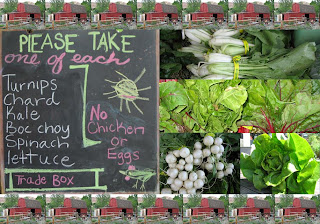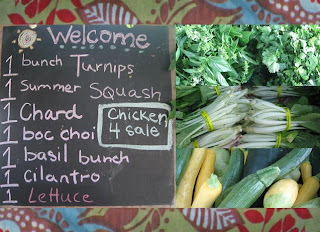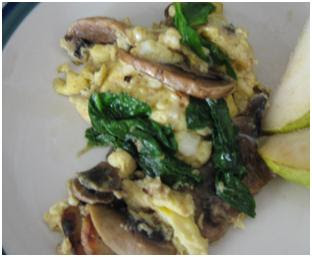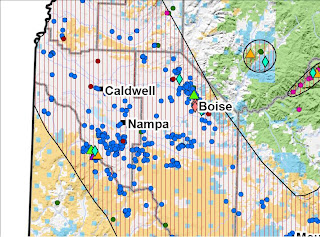There has been so much movement in the backyard - moving from a green, grassy and cool space to a dusty, dry and down-right dirty place (one that not many would care to call their sanctuary). A portion has been transformed - an inviting garden space is in full bloom with 2 smallish harvests already taken place... A space has been reserved for native grasses and plants and another spot has been designated a stone patio - the native plant and grass area will be the last in as we will be playing in the rocks all weekend long!
Pictures and more details to follow.
Thursday, July 24, 2008
Where does the time go?
Hot Summer Months Translates to a Load of Fresh Veggies!
I forgot to take the camera to the farm tonight when picking up our fresh food from the farm and unfortunately do not have a picture from the menu board... but this is what we got:
1 Head of Lettuce - 2 Bunches of Basil - 3 Squash, which included 2 yellow summer squash and 1 zucchini - 2 Walla Walla Sweet Onions - 1 Bag of New Potatoes (small red potatoes) - 1 Bunch of Orange and Red Beets
Thursday, July 17, 2008
Indoor Container Garden
We enjoyed our first "vine-ripe" tomato from our container garden this week! Mmm mm m - nothing tastes quite like  a fresh tomato!
a fresh tomato!
Locally Grown Food
 Week 8 Produce Pick-Up from the Peaceful Belly Farm...
Week 8 Produce Pick-Up from the Peaceful Belly Farm...Beets - Carrots - Fava Beans - Squash - Kale - Boc Choy - Red Leaf Lettuce
Sunday, July 6, 2008
Saturday, July 5, 2008
Backyard Prep
 A lot has happened in our backyard since the last backyard prep entry "Saying Goodbye to our Grass ...one section at a time."
A lot has happened in our backyard since the last backyard prep entry "Saying Goodbye to our Grass ...one section at a time."
Heavy equipment was brought in to break through the sod mesh and hard-packed earth. And at long last, each section of our yard is devoid of grass (makes it a little tough for the puppy to poo) - but it has opened up garden space that we can use to grow some of our own food this summer and fall with enough (fingers crossed) to put away for use in the cooler winter months. Oddly enough, I haven't taken many bare ground pictures and haven't taken any of the 15'X21' space earmarked for crops this year (tilled and rowed). However, in this picture you get a pretty good idea of the amount of sweat and tears that has been put into this project so far...and much of the far right side of the yard is designated garden space for now...
Oddly enough, I haven't taken many bare ground pictures and haven't taken any of the 15'X21' space earmarked for crops this year (tilled and rowed). However, in this picture you get a pretty good idea of the amount of sweat and tears that has been put into this project so far...and much of the far right side of the yard is designated garden space for now...
Seasonal Local Produce from the Farm
Carrot - Beets - Green Onion - Napa Cabbage - Bag of Shelling Peas - Lettuce - Cherries
Friday, July 4, 2008
Seasonal Local Produce from the Farm
Carrot - Green Onion - Napa Cabbage - Spinach - Lettuce Mix - Peas
 You haven't had a pea or a carrot until you've eaten them fresh from the farm... And yet, we chose to prepare a Slow-Roasted Salmon with Melted Cabbage recipe by Chef Michael Schlow, known for his work on PBS's Victory Garden with our Napa Cabbage and carrots with this week’s bounty.
You haven't had a pea or a carrot until you've eaten them fresh from the farm... And yet, we chose to prepare a Slow-Roasted Salmon with Melted Cabbage recipe by Chef Michael Schlow, known for his work on PBS's Victory Garden with our Napa Cabbage and carrots with this week’s bounty.
Slowly roasted med-rare salmon, carrot reduction sauce, bacon, fresh carrots and fresh napa cabbage combine to make your mouth water.
The complete recipe can be found at: http://www.pbs.org/wgbh/victorygarden/eat/recipes/salmon_cabbage.html#carrots.
Monday, June 16, 2008
Seasonal - Local Produce - From the Farm
 Harvested Weekly for Members to Pick Up
Harvested Weekly for Members to Pick Up Week 4 Peaceful Belly CSA Produce
Turnips - Chard - Kale - Boc Choy - Spinach - Lettuce
Saying "Goodbye" to Our Grass
one section at a time...
We used the Kanga to level the yard by digging dirt from the higher sections and depositing the soil in the lower areas. This task took approximately three days with the help of several friends.
In order to get to the soil, we needed to uproot the grass and that job called for a different tool all together - we rented a large front tined rototiller and worked the yard over several times.
Sunday, June 15, 2008
Kanga - the Earth Mover
 This little green machine is going to make "light-work" of our yard demolition... or so we thought.
This little green machine is going to make "light-work" of our yard demolition... or so we thought.
While it did make our job a lot easier (can you imagine digging up a yard manually?) the project is still huge.
Determining What Level Is
We've been busy in the backyard - but before we could start digging up our grass and moving the dirt around,  we had to determine what level was...
we had to determine what level was...
My husband engineered a water leveler and we learned that level was roughly 12 inches higher in many sections of our yard than the existing height. Clearly, it is going to take a lot of dirt to fill in the spaces and fortunately enough, there are sections of the yard that need to be brought down to create a level standing. After taking the water leveler around the yard, we found that the fence line level - the exact height that we needed to bring the dirt up to.
After taking the water leveler around the yard, we found that the fence line level - the exact height that we needed to bring the dirt up to.
Making Room for the Earth Moving Equipment
 There is only one way into the backyard and it was blocked by the geothermal tub and deck. It took two to move the empty tub and five to move the deck - We removed the fencing that closed off the back from the courtyard thereby creating a path for the equipment that we would use to remove the grass from the yard.
There is only one way into the backyard and it was blocked by the geothermal tub and deck. It took two to move the empty tub and five to move the deck - We removed the fencing that closed off the back from the courtyard thereby creating a path for the equipment that we would use to remove the grass from the yard.
(The tub was in this position for several days which caused the grass to yellow underneath.)
Friday, June 6, 2008
Benefits of Fresh Veggies
Week 3 Peaceful Belly Produce Pick-Up
Chard:
Ever used Chard in your kitchen before? Here’s a simple yet delicious way to use up some of the Chard from this week’s pick up at Peaceful Belly. Creamy Swiss Chard recipe: http://www.recipezaar.com/57123
While chard is a great source of Thiamin (also known as B1) plays a major role in converting carbohydrates and fat into energy. Chard is also a great source of Folate, Zinc, Vitamin’s A, C, E, K and B6. When eating Chard, you also receive the benefit of Calcium, Iron, and Dietary Fiber to name a few of the good – the only drawback that I could find was the high Sodium content found in Chard.
Green Onion:
(I don’t particularly care for the onion – of any sort, so you’re on your own with this one…)
Spinach:
Like Chard, Spinach is very high in Sodium and contains Zinc, Vitamin’s A, C, B6, E, K and Thiamin. Spinach is low in saturated fat and very low in cholesterol…
Ingredients
- Eggs – 3, scrambled
- Milk – splash (for eggs)
- A handful of spinach leaves.
- Mushrooms – 3 button mushrooms, sliced
- Garlic – 2 or 3 small cloves, crushed.
- Oil or butter for sauté
- Salt & pepper to taste
Method:
Scramble eggs and milk and set aside.
- In a non-stick skillet, warm oil or butter and once warm, add garlic – lightly brown
- Slightly increase temperature and add mushrooms
- Add the spinach leaves and continue to sauté
- Once the mushrooms and spinach leaves appear to be cooked through – add the eggs
- Allow the eggs to cook in layers – turning only after the bottom layer has cooked (this creates a fluffier scramble)
- Continue until the eggs are completely cooked
- Serve at once with fresh fruit, toast and juice.
Arugula:
With its distinctive peppery flavor, Arugula is also known as “rocket, roquett, rugula, and rucola.” Try Arugula with other leafy greens as a tossed salad – or add some Arugula, pine nuts, olive oil and Parmesan cheese to create a wonderful version of pesto sauce for pasta tonight.
Friday, May 30, 2008
How To: Clean - Prepare - Serve Seasonal Vegetables
Week 2 Peaceful Belly Produce Pick-Up
Turnip & Turnip Greens:
For bigger turnip, gently wash, peel and cube before adding to the skillet to sauté – add sliced carrots, freshly minced ginger, a healthy portion of fresh garlic and a handful of fresh cilantro to the mix – drizzle a small amount of olive oil (or butter), cover and allow to cook through (until vegetables are crisp tender)… The tantalizing aroma is sure to bring the family to the table!
Now for the Turnip Greens. Remove the large stems from the center of the greens; soak in a medium size bowl of water to dislodge any residual dirt and cook as you would any other leafy green.
Radish & Radish Greens: (Our recent variety looks to be an Easter Egg Radish)
To begin remove the greens from the radish as well as the spindly root and wash. While the radish is usually eaten raw I found several mouth-watering recipes online and this one seemed most appealing:
Recipe: (see http://giniann.wordpress.com/2006/12/23/radish-curry-saute-with-onions-garlic-and-chili/ for more recipes like this…)
Ingredients
A bunch of red radish - contains 6 to 8 radishes.
Onion- one small, sliced.
Garlic- 2 or 3 small cloves crushed
Green chilies - 8 small, crushed
Turmeric powder- a pinch.
Oil for sauté
Mustard seeds - a pinch
Curry leaves- a sprig
Salt to taste
The leaves: Roll all the leaves together and slice into long shreds.
Method:
1. Clean the radishes and cut them as you would slice an apple. Clean the leaves, if you want to use them in the dish.
2. In a pan, add some oil. When it is hot, add the mustard seeds.
3. When the mustard seeds splutter, add curry leaves and onions. Sauté for 3-5 mins till edges of the onions turn slightly brown.
4. Add the crushed garlic and chilis, and turmeric powder. Saute for about a minute or even less.
5. Add the radishes, mix well and add salt. Cook covered for about 3-4 mins.
6. Once the radish seems soft, remove the lid and crank up the heat. Saute on high heat for a couple more minutes. The radishes will be soft yet crunchy.
7. After you remove the radishes onto a plate, in the same pan quickly saute the leaves for a few seconds and add it to the top of the radishes.
8. For best results, serve right off the stove. The dish takes less than 15mins. Make this right before your meal.
When harvested young, radishes offer a nice crispy, tender flesh and mild taste.
Remember to use the Radish Greens. They are known to have a slight peppery flavor to them and can overpower the dinner plate if not use sparingly… however they can be cooked just as any other leafy green – or eaten raw.
Spinach:
Popeye sings: I’m strong to the finish, ’cause I eats me spinach… I’m Popeye the Sailor Man… What more do I need to say?
To preserve your precious produce, simply wrap the kale in a damp paper towel and pack in a plastic bag – it should stay fresh in the refrigerator for several days however many leafy greens such as kale will quickly wilt (it still tastes great and offers tremendously healthy nutrients.)
Whether you choose to sauté your bunch of kale or eat it steamed with cranberries and lightly toasted pine nuts, kale is a great source of nutrients. Packed with healthy amounts of fiber, beta-carotene, calcium, iron, folic acid as well as Vitamin C, ounce for ounce you are giving your body the recharge that it needs to stay in tip-top form!
Cilantro:
This herb has a tendency of wilting and loosing its robust flavor if left unused for too long. Wrap it in a damp paper towel and place in a plastic bag before storing it in the crisper drawer of the refrigerator for a few days.
Native to the Mediterranean region, this herb is found in most Mediterranean – Mexican – Spanish meals… The funny thing about this herb is its name or rather, what it is called when harvesting the fresh leaves versus harvesting its seed. Fresh Leaves: Cilantro – Seeds: Coriander.
Red Mustard:
A taste of horseradish is found in this fine leafy green. The peppery flavor is tamed by prolonged time on the stove – if you want “fire” then braise for a matter of minutes – if you are looking for a mild “flame” then let it stand a little longer.
I was told that this particular green really brings out the flavor of Seared Ahi Tuna by a reputable source and time permitting will report back with my experience…
Thursday, May 29, 2008
Seasonal - Local Produce - From the Farm
Turnip - Radish - Spinach - Kale - Cilantro - Red Mustard
Ever had a turnip? Well - until we joined the Peaceful Belly community supported agriculture (CSA) I hadn't. And I found that I really like them! We had an awesome Creamy Arugula Pesto and Veggie pasta dish, a restaurant grade Boc Choi and wild rice dinner and fresh tossed salad - all created with nutrient rich, locally grown organic vegetables.
Tuesday, May 27, 2008
Main Objective: A Year-Round Food Producing Yard (Garden)
Our main objective is to create a space that will produce an ample supply of produce 12 months a year. What vegetables are desirable throughout the year - what do we want grow during the winter months in our greenhouse (tomatoes) and what do we want to grow enough of during the summer months (zucchini) to store for use in December?
As my spouse mentioned this evening... we need to really consider the reality of our project - get away from the romanticism of owning and operating a personal greenhouse. For example, is there a more productive way of producing more fresh veg in our smallish backyard than erecting a full-fledged greenhouse? Dick Raymond and his book Dick Raymond's Gardening Year has come up several times during our conversation... Dick has shown that there are several ways in which to start plants without the use of a greenhouse and he goes on to show the novice gardener how to put vegetables away or store them for use during the off season. Actually, Dick talks about "hothouses" for what appears to be seedlings placed in their own containers covered by plastic... I stumbled upon Dick's "plant bank" section on page 74 that demonstrates how to create your own mini greenhouse. The idea here is that one can lengthen the growing season by enclosing (in the original garden spot) the tender vegetables on the spot without the hassle of moving produce in and out of a full-sized greenhouse.
If you have the time, I recommend reading this book. Dick Raymond's Gardening Year: A full year--month by month, step by step--guide to everything to grow in a vegetable garden by America's foremost gardener.
Monday, May 26, 2008
Backyard Prep (Pre-GeoGreenHouse)

We spent the day working in the yard. We have one access point to the backyard and it was blocked by fence that had to come down.
The "temporary" geothermal hot tub was drained and moved aside to make room and a portion of the deck is blocking our access point and will be moved aside as well in the near future.
The hot tub and fence opening is pictured here.
Next on our list of to do... leveling of the yard, we have investigated the type of machine needed to complete this project as well as the cost which is roughly $200 a day. To reach our backyard, we have to cross the canal and the bridge has been a topic of concern for us. Stabilization may be required before we can get to the other side.
Sunday, May 25, 2008
Dinner at the Ranch
Meet - Meat?
Last night a friend of ours, (not pictured here) invited friends and family to his family ranch for dinner. We were introduced to four beautiful steer and were fed a wide range of fresh, locally grown and prepared meals, (I'll ask for company names and report back if I can).
The topic of discussion during dinner was sustainable communities. Basically, what does local sustainability look like to you?
To the right, you can see a pedicab in action...
Saturday, May 24, 2008
Heating Systems in Geothermal Greenhouses
Heating installations with natural air movement (natural convection):
(a) aerial pipe heating
(b) bench heating
(c) low-position heating pipes for aerial heating
(d) soil heating - heating installations with forced air movement (forced convection)
(e) lateral position
(f) aerial fan
(g) high-position ducts
(h) low-position ducts
Friday, May 23, 2008
Cost and Environmental Benefits
Motivation: Cost Benefits
As stated in the US Department of Energy: Energy Efficiency and Renewable Energy website: "Idaho provides individuals with income tax deductions for alternative energy devices installed in their homes. Qualifying devices include renewable energy systems using geothermal resources such as geothermal heat pumps and water source heat pumps. The entire cost (100%) of the residential geothermal energy system can be deducted from the taxable income up to a maximum of $20,000. However, the deduction cannot exceed $5,000 in any one year. Forty percent of the total cost to construct and install the system can be deducted in the year the device was put into service, and 20% for the next three years. Contact http://www.tax.idaho.gov for details" (http://www1.eere.energy.gov/geothermal/gpw/profile_idaho.htm par. 12).
Motivation: Environmental Benefits
As with any natural resource, the potential of over exploitation is real, note however, that when geothermal heat is used in a sustainable manner the impact on the environment can be diminished.
The table below was found at: http://iga.igg.cnr.it/geo/geoenergy.php where they sited the original source as Lunis and Breckenridge (1991). As the International Geothermal Association notes, the "probability and severity of potential environmental impact of direct-use projects" [Geothermal] range from low (L), moderate (M), to high (H).
| Impact | Probability of Occurring | Severity of Consequences |
| Air quality pollution | L | M |
| Surface water pollution | M | M |
| Underground pollution | L | M |
| Land subsidence | L | L to M |
| High noise levels | H | L to M |
| Well blow-outs | L | L to M |
| Conflicts with cultural and archaeological features | L to M | M to H |
| Social-economic problems | L | L |
| Chemical or thermal pollution | L | M to H |
| Solid waste disposal | M | M to H |
In the early 30's Iceland burned fossil fuels for their main source of energy, fuels that were imported no less. Today, Iceland is known for their use of geothermal energy and some of the cleanest (air quality) cities in the world.
Thursday, May 22, 2008
Seasonal - Local Produce - From the Farm
Motivation: If we are what we eat... shouldn't we take a personal interest in what we eat?
And so we have, my family and I have taken off our food blinders and looked directly at what we choose to consume multiple times a day. That's where "Community Supported Agriculture" (CSA) comes in... for only $22 per week, we are sure to receive a healthy share of locally grown organic produce.
Peaceful Belly:
"The best of both worlds an urban certified organic farm and CSA. Specializing in vegetables which supply a CSA program, Capital City Farmers Market, the local Co-op and restaurants. Our bio-intensive 13 acre farm lies right at the base of the city's foot hills, three miles from down town, Boise. The farm is ran by eclectic couples wonderful employees and many volunteers. We all work very hard to try to connect people in the city of Boise to the people that grow the food they enjoy. Food should be grown close to the people that consume it" (LocalHarvest.com)
Wednesday, May 21, 2008
Geothermal Sources: Boise, Caldwell & Nampa
The Green Triangle Indicates "Greenhouse" Use
The Turquoise Diamond Indicates "Space Heating" Use
The Red Dots Indicate "Wells > 50 Degrees C.
The Blue Dots Indicate "Wells > / = 20 and < / = 50 Degrees C.
Idaho Geothermal Resources Map Publication No. - INEEL/MIS-2002-1618 Rev. 2 November 2003
As you can see from this chart, there are many sources of "hot" water in our area. And as indicated in my previous post, we are one of 200 homes already connected to the geothermal heat source... This should make our job of converting the back yard into a year-round produce growing hotspot a little easier.
Getting Started
First things first...
One: The Idea of Local Sustainability & An Eye-opening Introduction to the Industrial Food Processes
Motivation: The Omnivore’s Dilemma: A Natural History of Four Meals by Michael Pollan
As a freshman at Boise State University, I was inspired through my readings of Michael Pollan's work and made a few life changes. In his book, The Omnivore's Dilemma: A Natural History of Four Meals, Michael shares with the reader his findings of industrial food, including big organic industries. His findings in addition to personal research lead me to explore the possibilities of erecting a geothermal greenhouse in my neighborhood, actually, my backyard.
Motivation: Local Sustainability - Year Round Fresh Vegetables
Throughout the Spring '08 semester, my peers and I presented our discoveries of what it means to choose sustainable living - What I found was that we have an opportunity to support the local farmer, that we have a local committee that is working towards building a "buy local mind-set", and that as individuals, we can make a difference in our community through the choices that we make every day...
Based on the U.S. Department of Energy: Energy Efficiency and Renewable Energy online, 200 homes in the Boise area use geothermal water as their source of heat during the winter months - and we are lucky enough to be counted in those numbers.Our intentions are to utilize this resource to heat a year-round greenhouse, expanding upon the lessons learned while lessening our footprint on the world (http://www1.eere.energy.gov/geothermal/gpw/profile_idaho.html par. 2).













